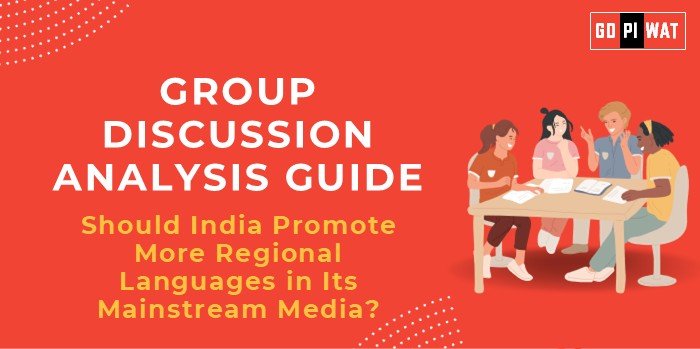📋 Group Discussion Analysis Guide
🌐 Should India Promote More Regional Languages in Its Mainstream Media?
🌟 Introduction to the Topic
India is a land of linguistic diversity, with 22 officially recognized languages and over 19,500 dialects spoken. While English and Hindi dominate mainstream media, the question arises whether regional languages deserve a more prominent place to reflect the true cultural tapestry of the nation.
Background: The 2011 Census of India reports over 43% of the population speaks Hindi as their first language, yet nearly 57% communicate primarily in other regional languages. The push for regional language media aligns with the goals of inclusivity, cultural preservation, and better reach to non-Hindi-speaking populations.
📊 Quick Facts and Key Statistics
- Languages in India: 22 scheduled languages, 121 major languages, and 19,500+ dialects.
- Media Reach: Regional TV channels accounted for 43% of viewership in 2023, up from 39% in 2020 (BARC).
- Literacy Rates: Literacy rates in regional languages exceed 75% in states like Kerala, Tamil Nadu, and Punjab.
- Digital Media Growth: Platforms like YouTube saw a 40% increase in regional content consumption in 2023 (IAMAI).
- Economic Scope: Regional film industries contribute ₹15,000 crore annually to India’s GDP.
🤝 Stakeholders and Their Roles
- Government: Formulates policies promoting linguistic diversity in media through subsidies and grants.
- Media Houses: Content creators and broadcasters hold the power to produce and distribute regional content.
- Viewers: Audiences drive demand for regional content, influencing market trends.
- Advertisers: Increasingly target regional audiences for localized marketing campaigns.
🏆 Achievements and Challenges
Achievements:
- Viewership Expansion: Regional media reach in states like Tamil Nadu and West Bengal surpasses national Hindi channels.
- Cultural Preservation: Platforms like Doordarshan and OTT services promote native storytelling and folklore.
- Employment Growth: Regional media industries create jobs for local talent.
- Inclusive Messaging: Campaigns in local languages foster better communication on social issues.
Challenges:
- Lack of Funding: Regional language channels often face lower ad revenue.
- Standardization Issues: Difficulty in maintaining consistent quality across languages.
- Technological Barriers: Inadequate resources for producing high-quality regional content.
- Global Comparison: Countries like Canada promote bilingualism through direct funding; India’s approach lacks similar focus.
📚 Structured Arguments for Discussion
- Supporting Stance: “Promoting regional languages in media strengthens national unity by giving a voice to underrepresented communities.”
- Opposing Stance: “Prioritizing regional languages may fragment audiences and dilute the reach of national-level messaging.”
- Balanced Perspective: “While regional media amplifies cultural richness, national strategies must ensure cohesion and consistent messaging.”
💡 Effective Discussion Approaches
- Opening Approaches:
- Statistical Impact: “With over 43% viewership in 2023, regional channels are the fastest-growing segment in Indian media.”
- Contrast Statement: “While Hindi dominates national media, Tamil, Telugu, and Bengali have larger audiences in their respective regions.”
- Global Benchmarking: “Canada’s successful promotion of bilingual content highlights how India could manage its linguistic diversity.”
- Counter-Argument Handling:
- Emphasize the inclusivity regional languages bring.
- Highlight successful cases like Kerala’s digital media policies.
- Advocate technological and funding solutions for production barriers.
📈 Strategic Analysis of Strengths and Weaknesses
- Strengths: Strong cultural identity; growing regional content demand.
- Weaknesses: Funding disparities; technological barriers in content production.
- Opportunities: Partnerships with OTT platforms; leveraging AI for multilingual content creation.
- Threats: Risk of linguistic fragmentation; decline in content quality without proper oversight.
📌 Connecting with B-School Applications
- Real-World Applications:
- Marketing strategies for localized campaigns.
- Operations management in multilingual media production.
- Sample Interview Questions:
- “How can regional language media contribute to India’s GDP?”
- “What role does inclusivity play in media strategies for diverse populations?”
- Insights for Students:
- Focus on market segmentation and regional advertising dynamics.
- Explore case studies on successful regional media campaigns.


